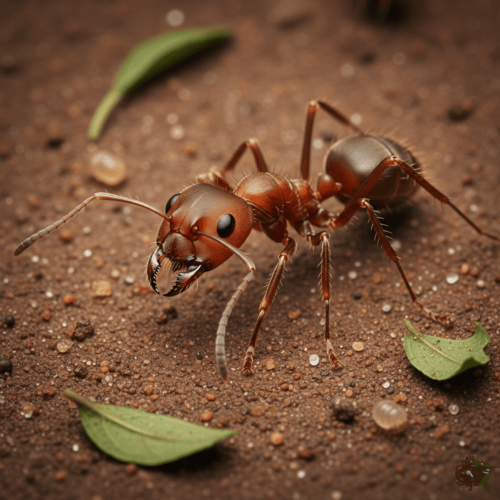Explosive Evidence: How the Bombardier Beetle Demolishes Darwinism
Imagine being chased by a predator 20 times your size. You’re cornered with nowhere to run. In a split second, you rotate your abdomen, aim with precision, and fire a boiling chemical spray that reaches 212°F—hot enough to burn your attacker while propelling you to safety. This isn’t science fiction; it’s the daily reality of the bombardier beetle, a tiny insect whose explosive defence system delivers a devastating blow to Darwin’s theory of evolution.
The bombardier beetle’s intricate chemical warfare capabilities provide some of the most compelling evidence for intelligent design found in nature. This marvel of bioengineering doesn’t just challenge evolutionary explanations—it obliterates them, pointing unmistakably to the handiwork of a divine Creator.
NATURE’S MOST SOPHISTICATED CHEMICAL WEAPON
The bombardier beetle carries what can only be described as a miniature chemical laboratory in its abdomen. Two separate storage chambers house the raw materials: hydroquinone and hydrogen peroxide, along with water. When threatened, the beetle releases these chemicals into a specialised reaction chamber where enzymes—catalase and peroxidase—trigger an explosive chemical reaction.
The result is nothing short of spectacular. In milliseconds, the temperature spikes to 212°F as the mixture transforms into a pressurised spray of toxic benzoquinones. This superheated chemical cocktail shoots from the beetle’s rotatable nozzle with remarkable accuracy, reaching distances up to eight inches—impressive for a creature barely half an inch long.
But here’s what makes this system truly extraordinary: the beetle can fire up to 500 rapid pulses per second, adjusting its aim with 360-degree precision. It’s like having a high-tech chemical turret mounted on a living tank. The success rate against predators? An astounding 99%. Ants flee, spiders retreat. Even frogs and birds learn quickly to avoid this tiny terror.
THE IRREDUCIBLE COMPLEXITY NIGHTMARE
This brings us to what evolutionary biologists prefer not to discuss: irreducible complexity. Biochemist Michael Behe demonstrated certain biological systems require all their components to be present and functional simultaneously—remove any part, and the entire system fails catastrophically.
The bombardier beetle represents irreducible complexity in its purest form. Consider what must be present for this system to work:
The chemical components themselves are useless in isolation. Hydroquinone alone won’t deter predators. Hydrogen peroxide by itself provides no defence. And combine them without the proper enzymes, and you get either no reaction or an uncontrolled explosion that would kill the beetle itself instantly.
The enzyme system must be precisely calibrated. Catalase and peroxidase don’t just need to be present—they must be in exact proportions to control the reaction rate. Too little enzyme, and no reaction occurs. Too much, and the reaction becomes uncontrollably violent.
The anatomical structure demands perfection from day one. The storage chambers must be chemically inert to prevent premature reactions. The reaction chamber requires specialized walls to withstand extreme heat and pressure. The valve system needs split-second timing to prevent backflow that would prove fatal.
The muscle control system must coordinate perfectly with the chemical timing. The beetle must aim accurately while managing the explosive force—a feat requiring integrated nervous system control of multiple muscle groups.
The evolutionary dilemma: None of these components provide any survival advantage alone. A beetle with hydroquinone but no hydrogen peroxide gains nothing. One with the chemicals but no enzymes dies from accidental explosions. Partial valve systems offer no protection while risking self-destruction.
Evolution demands gradual, step-by-step improvements where each stage provides survival benefits. But the bombardier beetle’s defence system is utterly unforgiving of partial solutions. It’s all or nothing—and “nothing” means extinction.
MATHEMATICAL IMPOSSIBILITY
Let’s examine this from a mathematical perspective. For the bombardier beetle system to evolve by chance, multiple independent genetic mutations would need to occur simultaneously, each producing precisely the right protein in exactly the right location with perfect timing.
The probability of getting just the correct amino acid sequence for one of the necessary enzymes by random mutations is approximately 1 in 10^77—a number so large it exceeds the estimated number of atoms in the observable universe. Now multiply that by the odds of developing the specialized anatomy, the chemical storage systems, the valve mechanisms, and the neural control networks all at once.
Information theory tells us functional, complex information—like the genetic code required for the bombardier beetle’s system—only comes from intelligence. We never observe random processes creating information-rich, functionally integrated systems. Yet evolutionary theory asks us to believe that mindless chance assembled a chemical defence system more sophisticated than anything human engineers have produced.
If we were to attempt to replicate the bombardier beetle’s capabilities, we’d require teams of PhD chemists, advanced laboratory equipment, and carefully controlled conditions. If our best minds struggle to copy this system, what does that tell us about its origin?
EVOLUTIONARY EXPLANATIONS FALL SHORT
Evolutionary biologists have proposed various pathways for the bombardier beetle’s development, but each explanation crumbles under scrutiny. They suggest that simpler chemical defences gradually evolved into the complex explosive system we observe today. However, this theory faces insurmountable problems.
First, there are no intermediate forms. We don’t find beetles with partially developed chemical systems or transitional species with simpler explosive mechanisms. The fossil record shows bombardier beetles appearing fully formed with their complete defense system intact—exactly what we’d expect from special creation.
Second, the “co-optation” argument—claiming that existing biological systems were borrowed and repurposed—fails to account for the system’s integration. Even if enzymes from other biological processes could theoretically be repurposed, this doesn’t explain how they became precisely calibrated for explosive chemical defence while simultaneously developing the necessary anatomical structures.
Third, the geographic distribution of bombardier beetles worldwide suggests rapid dispersal from a single origin point rather than independent evolution in multiple locations. This pattern aligns perfectly with the biblical account of creatures spreading across the earth after Noah’s flood.
THE BOMBARDIER BEETLE: THE VERDICT OF EVIDENCE
The bombardier beetle demolishes Darwinism not through philosophical arguments but through hard scientific evidence. Its irreducibly complex chemical system defies evolutionary explanation while pointing unmistakably toward intelligent design. The mathematical impossibility of chance assembly, combined with the absence of transitional forms and the failure of proposed evolutionary pathways, builds an ironclad case for special creation.
When we examine this remarkable creature honestly, we’re confronted with a choice: blind faith in an impossible evolutionary scenario, or recognition of the obvious—that such sophisticated engineering requires an Engineer. The bombardier beetle’s explosive testimony declares the glory of its Creator and invites us to worship the God whose wisdom is displayed even in the smallest details of His creation.
The evidence is explosive, and the verdict is clear: the bombardier beetle is living proof that “In the beginning, God created.”
THE BOMBARDIER BEETLE: RELATED FAQs
What military applications are scientists developing based on the bombardier beetle? Military researchers are studying the bombardier beetle’s explosive mechanism to develop new non-lethal crowd control systems and advanced propulsion technologies. The beetle’s ability to generate controlled explosions without harming itself has inspired research into safer chemical propellants for rockets and missiles. Defence contractors are also exploring how the beetle’s rapid-fire capability and precision targeting could improve automated defence systems. The creature’s remarkable efficiency has even sparked interest in developing miniature chemical reactors for military field applications.
- How are industries using bombardier beetle research for practical applications? Chemical engineers are reverse-engineering the beetle’s reaction chamber design to create more efficient industrial mixing systems and safer chemical processing equipment. The pharmaceutical industry is particularly interested in the beetle’s precise enzyme control mechanisms for developing better drug delivery systems. Automotive companies are studying the beetle’s explosion-dampening chambers to improve airbag deployment systems and engine efficiency. Additionally, the pest control industry is developing targeted, biodegradable repellents based on the beetle’s chemical formulations.
- Are there other creatures with similar explosive defence mechanisms? While several insects use chemical defences, none match the bombardier beetle’s sophisticated two-stage explosive system. Some termites can explode their bodies to release toxic chemicals, but this is a one-time suicide defence rather than the beetle’s reusable system. Certain ants and millipedes secrete irritating chemicals, but they lack the explosive delivery mechanism and temperature control that makes the bombardier beetle unique. The bombardier beetle remains unparalleled in the animal kingdom for its combination of chemical sophistication and mechanical precision.
- Can laboratory experiments create a bombardier beetle’s defence system artificially? Despite decades of research and advanced technology, scientists have never successfully replicated the bombardier beetle’s complete system in the laboratory. While researchers can recreate individual chemical reactions, they cannot duplicate the beetle’s integrated biological control mechanisms, self-repair capabilities, and miniaturised efficiency. The closest human approximations require bulky equipment, external power sources, and careful monitoring—highlighting the superior engineering of the original biological system. This failure of human intelligence to fully replicate the system strongly suggests it required an Intelligence far greater than our own.
How many different species of bombardier beetles exist, and do they all work the same way? Scientists have identified over 500 species of bombardier beetles worldwide, and remarkably, they all employ the same basic two-chamber explosive system with only minor variations. This consistency across different species and geographic regions supports the creation model rather than independent evolution. While there are slight differences in chemical concentrations and nozzle designs, the fundamental engineering principles remain identical. This uniformity suggests a common Designer who used the same brilliant solution across multiple beetle kinds, rather than random evolutionary processes independently arriving at identical complex systems.
THE BOMBARDIER BEETLE: OUR RELATED POSTS
- Nature’s Puzzle: The Platypus as Evidence of Divine Engineering
- Bats: How Nature’s Flying Marvels Defy Evolution
- Tadpole to Frog: How Metamorphosis Reveals Divine Programming
- Honeybees: 5 Ways Nature’s Unsung Architects Point to the Creator
- Testament to Design: The Engineering Marvel of Elephants
- Blue Whales: Mammoth Icons of Intelligent Design
- The Woodpecker’s Design: How Nature’s Headbanger Defies Evolution
- Too Perfect to Be Random: The Giraffe’s Remarkable Design
- Evidence that Glows: How Bioluminescence Reveals Design
Editor's Pick

GPS Without Eyes: How Ants Silently Shout Intelligent Design
Picture a leafcutter ant navigating the rainforest floor in pitch darkness, carrying a leaf fragment 50 times its body weight. [...]

Born Broken: Why Must We Affirm Original Sin?
Imagine a world where we’re born neutral—free to choose good, and without a bias toward evil. Sounds appealing… until we [...]

Does God Truly Care About My Everyday Choices?
OWe believe God created the universe. We believe He orchestrated the exodus from Egypt and raised Jesus from the dead. [...]
SUPPORT US:
Feel the Holy Spirit's gentle nudge to partner with us?
Donate Online:
Account Name: TRUTHS TO DIE FOR FOUNDATION
Account Number: 10243565459
Bank IFSC: IDFB0043391
Bank Name: IDFC FIRST BANK






